Will Devlin, Sarah Woods and Brendan Coates1
High and volatile commodity prices have returned as a significant global issue, with the prices of many commodities returning to around their mid-2008 peaks. This paper provides an overview of the fundamental drivers of recent price trends and considers the role played by financial speculation in commodity price formation.
It concludes that recent volatility is not without historical precedent. Similar levels of (nominal) price volatility have been observed at various times over the post-war period, particularly during the 1970s. It also concludes that a series of unexpected demand shocks explains most of the variation in commodity prices over recent years.
While it is empirically difficult to completely rule out a causal link between speculation in commodity derivatives markets and short-lived volatility in commodity prices, there are strong grounds to conclude that speculation has not had a systematic impact on recent commodity price dynamics.
Introduction
High and volatile commodity prices were a significant global issue over 2007 and into 2008. While the escalating financial crisis over the second half of 2008 — and the precipitous decline in commodity prices that accompanied it — took much of the attention away from the issue for a period, the prices of some commodities have now returned to around their mid-2008 peaks. The causes and consequences of high and volatile commodity prices are again attracting attention.
At their London meeting in September 2009, G20 Finance Ministers and Central Bank Governors committed to 'work to address excessive commodity price volatility.' Subsequently, at the Seoul Summit in November 2010, Leaders agreed to continue work 'to mitigate excessive fossil fuel price volatility' and identified the need for 'further work on regulation and supervision of commodity derivatives markets'. France has placed commodity price volatility as a key item on the G20 agenda during its current host year.
This paper provides some background on commodity price movements. It is divided into four parts. First, a survey of the behaviour of commodity prices over the past decade, and putting this in a historical context. Second, an overview of some of the fundamental drivers of recent price trends, as well as the degree of speculative activity in commodity derivatives markets. Third, a review of the existing empirical evidence on the role played by financial speculation in commodity price formation. Finally, some thoughts on areas where additional work could be undertaken in 2011.
Recent trends in commodity markets
Commodity markets have, at various times, exhibited significant price volatility. The combination of inelastic demand and supply in many commodities means that, at least in the short term, unanticipated changes in demand or supply can generate large price swings.
Beginning in around 2002, commodity markets entered a strong and sustained uptrend. By its peak in mid-2008, this upswing had seen the prices of almost all classes of commodities rise substantially. For many commodities, the pace of price increase accelerated during the period between January 2006 and July 2008 (Chart 1).2 The crude oil price, in particular, more than doubled over this relatively brief period.
Chart 1: World commodity export prices (nominal, spot indices)(a)
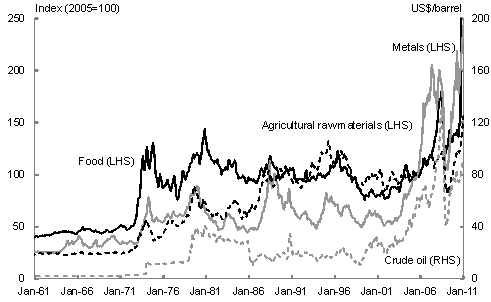
(a) The Agricultural raw materials index is composed of timber, cotton, wool, rubber and hides.
Source: IMF International Financial Statistics.
The speed and magnitude of this run-up in commodity prices is rivalled by only two other episodes in the last century. One was the commodity price boom in the mid-1930s — which was largely a bounce back from the sharp declines seen during the Great Depression — and the other was the price boom in the 1970s.3
During the second half of 2008, commodity prices quickly corrected with the escalating global financial crisis and associated downward revisions to forecasts for global economic growth. From July 2008 to March 2009, commodity prices fell precipitously, reversing most of the gains made over the preceding years. Broad indices of commodity prices reached a trough in March 2009. At a broad level, commodity prices have since recovered more than half of what they lost during the crisis period. Indeed, the prices of some commodities have now surpassed — or close to — their mid-2008 peaks.
Concurrent with the run-up in commodity prices, volatility in prices has also been elevated over recent years. However, such volatility is not without historical precedent. Similar levels of (nominal) price volatility have been observed at various times over the post-war period, particularly during the 1970s (Chart 2).4
Chart 2: World commodity export prices — historical volatility(a)
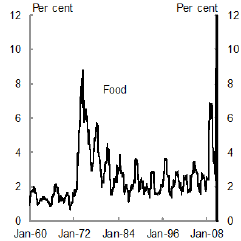
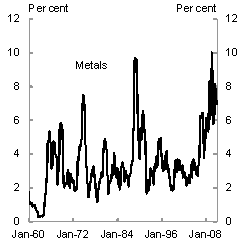
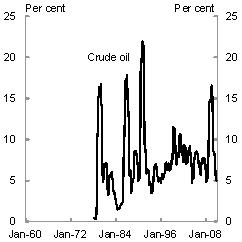
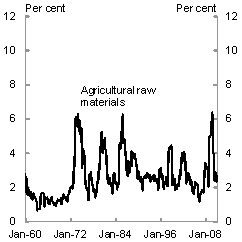
(a) Volatility is measured as the standard deviation of month-on-month per cent changes over rolling 12-month windows.
Source: IMF International Financial Statistics.
The fundamental drivers of recent volatility in commodity prices
As in the 1970s, commodity markets have been subject to a number of shocks over the past decade. In contrast to the 1970s, however, the most prominent shocks to hit commodity markets over the past decade have been on the demand side. Led by strong growth in emerging economies, global economic growth averaged 5 per cent per annum between 2004 and 2007 — the strongest four year growth period since the early 1970s. To a significant extent, the strength of the growth impulse from emerging economies was unexpected.5
Moreover, this global economic growth cycle was commodity-intensive. Driven by exceptionally strong demand growth from the industrialising economies, particularly China and India, inventories of many major commodities over this period fell to near historically low levels. Commodity demand was also supported by fiscal expansion, an extended period of accommodative monetary policy in key economies and a trend decline in the value of the US dollar (in which most commodities are priced).
Supply side factors were, however, not completely absent from the story. A long period of low and declining commodity prices prior to 2002 had resulted in significant underinvestment in new supply capacity globally — particularly in extractive industries. As a consequence, the supply response to surging commodity prices from 2002 onwards was sluggish, particularly given the typically long delays between investment and production. For agricultur
al commodities, adverse weather conditions in some key producers, as well as the diversion of some food commodities to the production of biofuels in some countries, were also important. These supply constraints were intensified by policy actions taken by some countries in 2008 to quarantine production for domestic use.
The precipitous decline in commodity prices from mid-2008 was associated with the sharpest collapse in global economic growth in the post-war period. The timing and magnitude of this collapse in growth took commodity markets — and economic forecasters — by surprise. As late as July 2008, for example, the International Monetary Fund (IMF) revised up its forecasts for world growth in both 2008 and 2009.
In summary, most of the run-up in commodity prices to mid-2008 can be explained by a series of unexpected demand shocks, combined with a weak supply response. The sharp downturn in global economic activity in the wake of the global financial crisis also explains much of the subsequent decline in commodity prices.
A controversial issue is whether speculative activity in related financial markets has also played a meaningful role in influencing the recent movement in commodity prices — the run-up in prices to 2008, and associated increase in price volatility, also coincided with an increase in the prominence of financial investors in commodity markets.
The role of speculation in commodity markets
Speculation in commodity derivatives markets performs a valuable economic function. Firstly, speculation in these markets allows for the transfer of price risk from those least willing to bear it (commodity producers and consumers, or 'end users') to those with the greatest appetite and capacity to do so (generically, 'speculators'). Depending upon where prices are at any given moment, commercial hedgers seeking to buy and those seeking to sell are rarely motivated to do so at the same time. Without the liquidity provided by speculators, end users would be unable to use derivatives markets to effectively hedge their commercial exposures.
Secondly, derivatives markets transmit valuable information about supply and demand conditions. Traders or firms with information about these fundamentals can buy or sell if this information implies that the current price is too low or too high. This informed trading forces prices towards their correct (or, 'true') level. Producers, consumers and inventory holders of the commodity can, in turn, use the information embedded in derivatives prices to make better resource allocation decisions.
The question is not whether speculators can influence movements in commodity prices — clearly they can, and it is desirable for them to be able to do so. Rather, it is whether speculation can force prices to diverge, for any meaningful period of time, from what is justified on a fundamental basis. A more appropriate characterisation of the debate is the scope for commodity markets to be affected by destabilising speculation.
Proponents of the view that speculation has played a destabilising role in commodity markets over recent years draw particular attention to the recent growth in index fund investment in commodity derivatives.6 The proposition is that the weight of money flowing into commodity derivatives markets from index funds over recent years — almost all of which was on the long side — drove up futures prices, and with it, the spot price of the underlying physical commodities themselves.
Underlying this argument is the assumption that money flows into futures markets can simply be equated with increasing real demand for the underlying physical commodities. However, futures markets are 'zero-sum' markets where all money flows must, by definition, net to zero — for every long position there is a corresponding short position. Theoretically, there is no limit to the number of futures contracts that can be created at a given price level (Irwin and Sanders 2010).
Moreover, the predictability and transparency with which commodity index funds operate raises doubts about the ability of such investors to drive prices away from what would be justified on a fundamental basis. Commodity index funds typically publish in advance their mechanical procedures for rolling to new contract months as well as their desired market weightings whenever the reference index is rebalanced. It is unlikely that other well-capitalised speculators, such as commodity trading advisers, hedge funds, and large floor traders, would allow index funds to push futures prices away from fundamental values when index trades are so transparent and so easily anticipated. Indeed, such sophisticated investors have likened their ability to engage in profitable trades as index funds roll over to new contract months as 'like taking candy from a baby' (Irwin et al 2009).
The most intuitively appealing test of whether speculation could push commodities futures prices away from fundamentals and, through arbitrage, spot prices, is to test for a relationship between changes in futures positions held by financial investors and changes in futures prices. The most widely used dataset for performing such a test is the US Commodity Futures Trading Commission's (CFTC) weekly reports of positions by trader category.7 Empirical tests of CFTC positions level data — including by the IMF, OECD and the CFTC itself — have generally not supported the conclusion that the level of speculation in commodity derivatives markets has had a destabilising effect on prices (see, for example, International Monetary Fund 2006a, Irwin and Sanders 2010, US Interagency Taskforce on Commodity Futures Markets 2008). A few studies have also employed daily disaggregated data from the CFTC's large trader database and have reached the same conclusion (see, for example, Buyuksahin et al 2010, and Aulerich et al 2010).
The consistency of empirical evidence in this area is compelling, albeit not necessarily definitive. Such an approach relies on being able to accurately distinguish between speculative and hedging activity in a market. In reality, the distinction between hedging and speculation in futures markets is less clear than it may seem. Traditionally, traders with a commercial interest in or an exposure to a physical commodity have been called hedgers (or, commercial traders), while those without a physical position to offset have been called speculators (non-commercial traders). Commercial traders, however, often take a view on the price of a commodity or may not hedge in the futures market despite having an exposure to the commodity — positions that could be regarded as speculative.8
Similarly, there is some empirical ambiguity over the extent to which fundamental dynamics can fully explain movements in commodity prices over the past decade. At any given time, of course, the true (or, correct) price of a given commodity is unobservable. Correctly identifying all the factors influencing commodity prices, including the role played by expectations of future supply and demand fundamentals, means that such a modelling approach is not straightforward and fraught with uncertainty. Moreover, assuming it is possible to identify those fundamental price determinants, such an approach relies on being able to measure changes in those factors accurately — the quality and reliability of data is a significant problem in some commodity markets.
Nevertheless, there are grounds to conclude that the level of speculation in commodity derivatives markets has not had a systematic influence on commodity prices. One of the most compelling is that the prices of commodities without actively traded derivatives markets (such as LNG, coal and iron ore, among others) appreciated at least as strongly during the run-up to mid-2008 as commodities with active derivatives markets.
If speculation in commodity derivatives markets was driving prices above what was justified, one would expect to have seen larger price increases in those markets with actively traded derivatives markets. This was not the case in the run up to mid-2008, nor has it been the case in the most recent experience of rising commodity prices.
A related observation is that, if speculation in commodity derivatives was having a significant price effect, there should be a weakening in the historical correlation between spot prices in those markets with and without active derivatives markets. In fact, historical correlations between spot prices for commodities with active derivatives markets and those without have not weakened in recent years as speculative activity has risen.9
In addition, price movements across commodities are not synchronised. For example, whereas the prices of some commodities (such as iron ore and some agricultural commodities) have returned to levels around their mid-2008 peaks, the prices of several other commodities (such as crude oil, LNG and rice) remain significantly below their previous peaks. Some commodities (such as copper, sugar and cotton) have gone well beyond their previous peaks. While commodities have many common macro drivers, this asynchronous behaviour shows that they are responding to their own unique supply and demand dynamics.
Finally, one of the key signatures of a speculative bubble in a market for a storable commodity is an accumulation in physical stocks (inventories). If financial speculation in commodity derivatives was driving prices above the levels required to equilibrate demand and supply for the underlying commodity, then this would be evidenced by an inventory build, or production would have to be reduced to compensate. Notwithstanding concerns over the reliability of some commodity market data, there is little evidence to suggest that physical hoarding accompanied the large run-up in the prices of storable commodities to mid-2008. For example, inventories of many agricultural commodities actually declined over most of that period, while inventories of other commodities such as crude oil were flat.10
Some issues to explore
While it is empirically difficult to completely rule out a role for speculation in commodity derivatives markets to increase price volatility, there are strong grounds to conclude that speculation has not had a systematic impact on recent commodity price dynamics. At best, the issue is whether speculative activity can have a modest and short-lived influence on commodity prices and, even at that level, the evidence is far from conclusive. Moreover, speculation in these markets performs a valuable economic function.
There are, however, a number of areas where the functioning of commodity markets could be improved.
As a first step, there would be merit in developing a deeper understanding of the interaction between physical and financial markets for commodities. Towards this end the International Energy Agency (IEA), the International Energy Forum (IEF) and the Organisation of the Petroleum Exporting Countries (OPEC) has a work program aimed at improving the understanding of the linkages between the physical and financial markets for energy. This work could be extended — via an appropriate forum — to encompass all commodity markets, including agricultural commodities.
Improving the quality and timeliness of data on physical market fundamentals is an important step towards addressing price volatility. Price volatility in commodity markets is intimately linked to uncertainty. The lack of timely and comprehensive physical market data — particularly in non-OECD countries — continues to hamper the efficient functioning of both physical commodity markets and related financial markets. To date, the G20 has endorsed and supported the work of the IEF on improving data quality and transparency in oil markets — via its Joint Oil Data Initiative (JODI). There is much scope for relevant international organisations to pursue similar data initiatives in the non-oil commodities space.
Improving transparency in the markets for commodity derivatives — particularly those traded over-the-counter (OTC) — is important. Commodity derivatives markets, in some circumstances, can be susceptible to deliberate manipulation. Manipulation in derivatives markets can make prices excessively volatile and reduce their informational content, and cause costly distortions in physical commodity markets. Indeed, deterring market manipulation is the primary objective of derivatives market regulations in most jurisdictions. Yet, the ability of market authorities to adequately detect and combat market abuse has been limited by the almost complete absence of transparency in OTC derivatives markets.
The Financial Stability Board's (FSB) Working Group on OTC Derivatives has provided recommendations to significantly improve the transparency and oversight of OTC derivatives markets, including those referencing commodities. Among the FSB's recommendations is that '[A]uthorities must require market participants to report all OTC derivatives transactions ... in a timely manner to trade repositories'. Trade repositories can significantly increase the transparency of positions in OTC markets. The International Organisation of Securities Commission's (IOSCO) Task Force on Commodity Futures Markets has been working with major market participants exploring the case for a trade repository for commodity derivatives.
Finally, work should be directed at removing domestic policy distortions in physical commodity markets, particularly in agricultural commodity markets. Policy settings designed to alter the prices paid or received by domestic consumers or producers — by distorting the incentives producers and consumers face to increase or decrease consumption or production — cause international prices to fluctuate to a much greater degree than would otherwise be the case. Indeed, the IMF has highlighted research showing that volatility in world food prices could be substantially reduced if all countries ceased to insulate their domestic markets (IMF 2006b). Ensuring free, fair and open access to global commodity markets is therefore critical, both for smoothing commodity price volatility and for achieving the twin goal of improving global food security.
References
Aulerich, N M, Irwin, S H and Garcia, P 2010, 'The price impact of index funds in commodity futures markets: evidence from the CFTC's daily large trader reporting system', University of Illinois Discussion Paper.
Buyuksahin, B, Brunetti, C and Harris, J 2010, 'Is speculation destabilising?' US Commodity Futures Trading Commission Working Paper.
International Energy Agency 2008, Medium Term Oil Market Report, July, pp 10-13.
International Monetary Fund 2006a, 'Has speculation contributed to higher commodity prices', World Economic Outlook, Box 5.1 (Chapter IV), September.
International Monetary Fund 2006b, World Economic Outlook, Box 5.2 (Chapter V), September.
Irwin, S H and Sanders, D R 2010, 'The impact of index and swap funds on commodity futures markets: preliminary results', OECD Food, Agriculture and Fisheries Working Papers, no. 27, OECD Publishing.
Irwin et al 2009, 'Devil or angel? The role of speculation in the recent commodity price boom (and bust)', Journal of Agricultural and Applied Economics, 41(2), August.
Korniotis, G M 2009, 'Does speculation affect spot price levels? The case of metals with and without futures markets', Finance and Economics Discussion Series, Division of Research and Statistics and Monetary Affairs, US Federal Reserve Board.
O'Connor, J and Orsmond, D 2007, 'The recent rise in commodity prices: a long-run perspective', Reserve Bank of Australia Bulletin, April.
OECD 2010, 'Developments in commodity price volatility', Working Party on Agricultural Policies and Markets, OECD Trade and Agriculture Directorate, October.
US Interagency Taskforce on Commodity Futures Markets 2008, Interim Report, July.
1 This paper was prepared ahead of the G20 Finance Deputies meeting in Paris on 17-18 February. The authors are from Macroeconomic Group, the Australian Treasury. We are grateful for research assistance provided by Cedric Hodges, also of Macroeconomic Group. This article has benefited from comments and suggestions provided by Michael Callaghan, Damien Dunn and Bill Brummitt. The views in this article are those of the authors and not necessarily those of the Australian Treasury.
2 In real terms, however, the run-up to mid-2008 only partially reversed a multi-decade decline in commodity prices.
3 For a detailed summary, see O'Connor and Orsmond (2007).
4 For a more detailed examination of historical volatility in agricultural commodity prices, see OECD (2010).
5 For instance, in World Economic Outlook publications between April 2005 and July 2007, the IMF consistently upgraded its forecasts for growth in emerging economies.
6 A commodity index fund is a financial product offering investors a synthetic way to take a position in a commodity, or basket of commodities, without ever having to take physical delivery. Commodity index funds arose because most institutional investors do not have access to the sophisticated trading operations necessary to manage a diversified commodity index portfolio using futures contracts. Typically, the approach is to take a long position in a near-term futures contract (referencing some underlying commodity index), sell it a few weeks before expiry, and use the proceeds to take the long position in a subsequent near-term futures contract.
7 The CFTC Commitment of Traders report provides data on futures positions classified by trader group for a range of commodities. This report only provides data on a weekly basis and is highly aggregated.
8 Energy trading desks within airline companies, for instance, are classified as hedgers, even though they often trade for the purposes of making speculative profits.
9 For example, Korniotis (2009) showed that the co-movement between metals prices with and without futures contracts has not weakened in recent years as speculative activity has risen.
10 See, for example, International Energy Agency (2008).